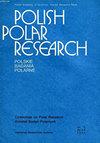从北极永久冻土层影响地区的湖泊沉积物中分离出的腐植酸分子组成的环境方面
IF 0.8
4区 地球科学
Q4 ECOLOGY
引用次数: 2
摘要
本文章由计算机程序翻译,如有差异,请以英文原文为准。
Environmental aspects of molecular composition of humic acids isolated from lake sediments of a permafrost-affected area of the Arctic
: Humic substances are ubiquitous in terrestrial and aquatic ecosystems. Humic acids (HAs) actively interact with organic and inorganic components of lake sediments. This interaction depends on the molecular structure and elemental composition of HAs. The presented research focuses on the investigation of the composition and molecular structure of humic acids isolated from lakes located in the Lena Delta in the Russian Arctic. The findings of the research are needed to estimate the potential capacity of humic acids to bind microelements, particularly toxic metals, in stable compounds. Surface sediment samples (0–10 cm) were collected from 8 lakes by Van Veen grab during the summer period of the “Expedition LENA 2019”. We analyzed elemental composition of the HAs samples. The results showed that the studied HAs of lake sediments are characterized by low nitrogen content and prevalence of aliphatic fragments in their molecular structure. Furthermore, it was found that the studied humic acids are less mature, showing mineralization processes dominant over humification, and have relatively low potential to complexation compared with soils of the Lena Delta as well as lake sediments of territories with more boreal climate conditions.
求助全文
通过发布文献求助,成功后即可免费获取论文全文。
去求助
来源期刊

Polish Polar Research
ECOLOGY-GEOSCIENCES, MULTIDISCIPLINARY
CiteScore
2.00
自引率
7.70%
发文量
0
审稿时长
>12 weeks
期刊介绍:
The quarterly Polish Polar Research edited by the Committee on Polar Research of the Polish Academy of Sciences is an international journal publishing original research articles presenting the results of studies carried out in polar regions.
All papers are peer-reviewed and published in English.
The Editorial Advisory Board includes renowned scientist from Poland and from abroad.
 求助内容:
求助内容: 应助结果提醒方式:
应助结果提醒方式:


